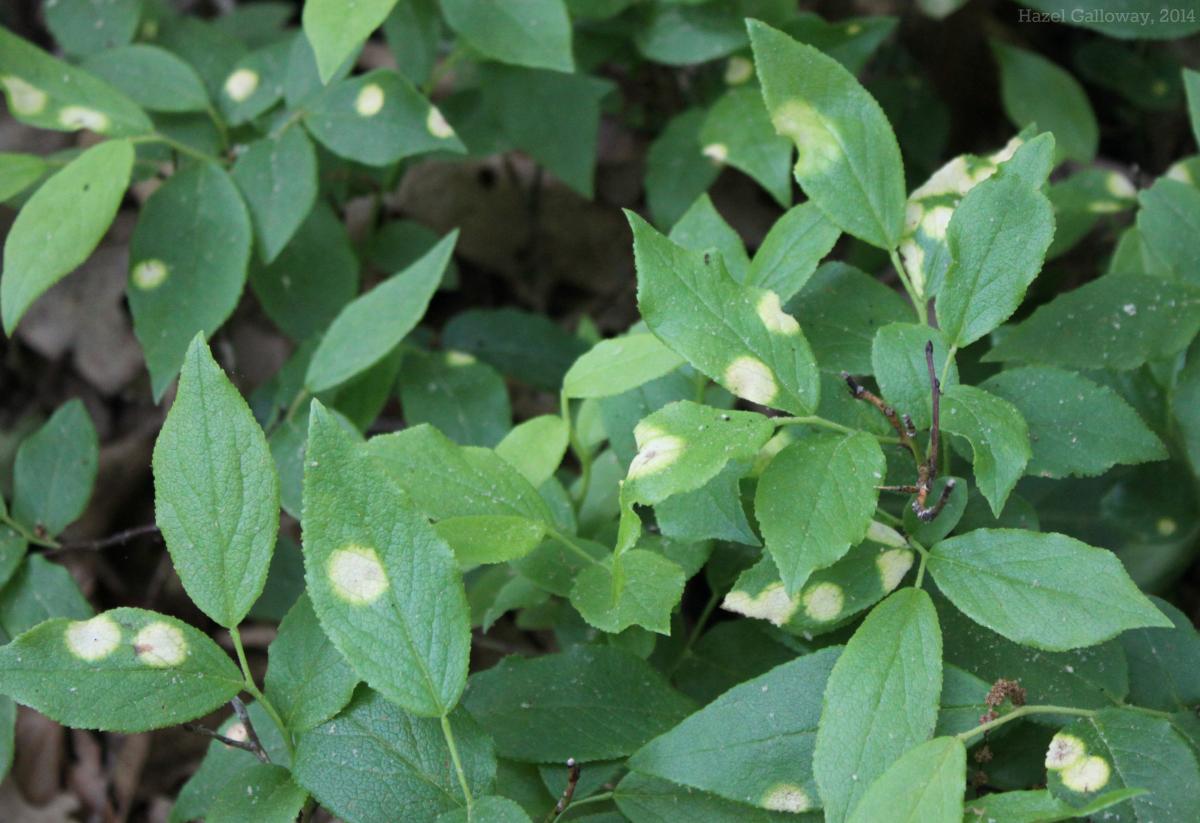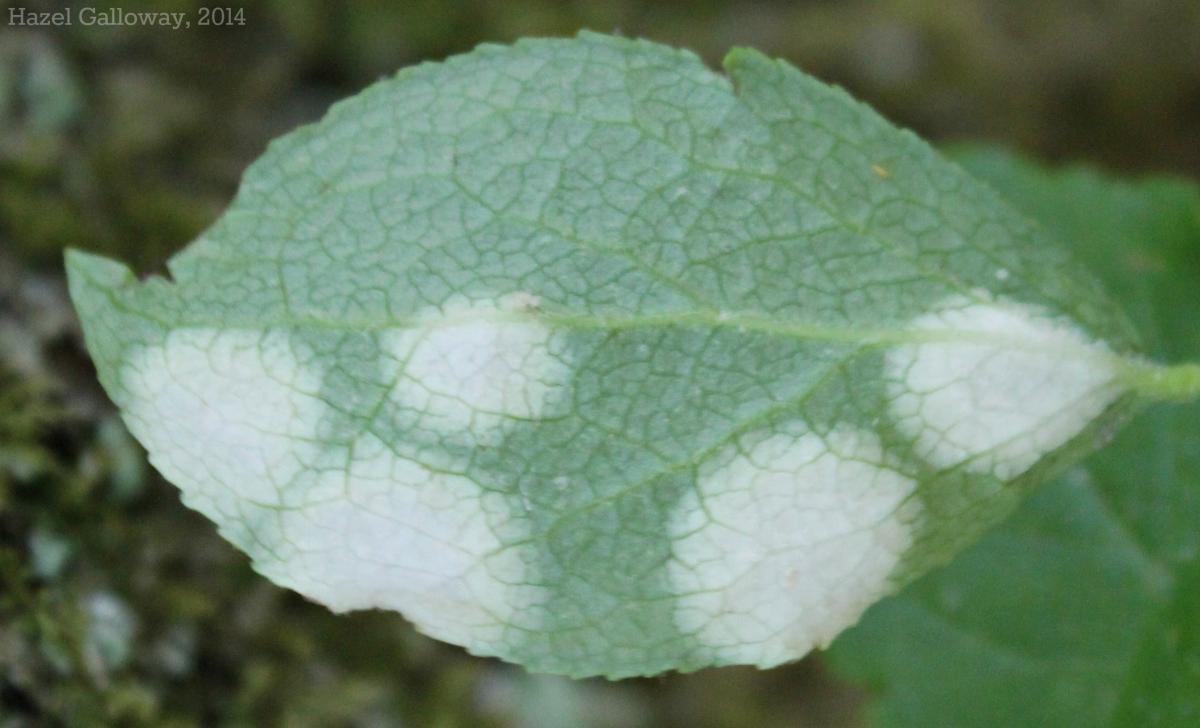Exobasidium vaccinii, the same fungus species responsible for the large, fleshy galls seen on the previous Organisms (the flame and roseshell azaleas) has also been known to infect plants from cranberries to camellia flowers. As early as 1987, it was identified as the source of the “red leaf disease” of lowbush blueberries. Along with causing its namesake leaf discoloration, the disease decreases flower number and berry yield in affected plants. Eleven years later, in 1998, E. vaccinii was found to be the source of a different infection of blueberry plants which caused them to develop “sharply delineated green spots…on otherwise normal ripe fruit…spots on affected leaves were circular, 4 to 7 mm in diameter, light green, slightly thickened, and smooth on the upper surface; the underside was covered with dense white fungal growth” (Cline, 1998). That one fungal species could cause effects this disparate on a number of species has led several authors to describe E. vaccinii as a species complex.
 An article published just over a week ago in the journal Mycologia attributes these leaf and fruit spots, thought to be the work of E. vaccinii, to a completely distinct species of fungus which the authors describe as Exobasidium maculosum. The researchers sequenced the large subunit of rDNA from samples of these leaf and fruit spots found on various blueberry species from Georgia, North Carolina, Maine, and Nova Scotia. In comparing those data to sequences obtained from fungi causing similar diseases, as well as morphological analysis, the researchers concluded that there was a substantial difference between the leaf-spot-causing fungus and previously described species. However, they noted that “leaf spot isolates from lowbush blueberry [as opposed to rabbit eye blueberry, highbush blueberry, and southern highbush blueberry also sampled] were genetically different and likely represent a unique species.” Because of this uncertainty, along with the impossibility of conclusively identifying many fungi using visible characteristics alone, the organism responsible for the leaf spotting on lowbush blueberries around the station cannot be identified to species.
An article published just over a week ago in the journal Mycologia attributes these leaf and fruit spots, thought to be the work of E. vaccinii, to a completely distinct species of fungus which the authors describe as Exobasidium maculosum. The researchers sequenced the large subunit of rDNA from samples of these leaf and fruit spots found on various blueberry species from Georgia, North Carolina, Maine, and Nova Scotia. In comparing those data to sequences obtained from fungi causing similar diseases, as well as morphological analysis, the researchers concluded that there was a substantial difference between the leaf-spot-causing fungus and previously described species. However, they noted that “leaf spot isolates from lowbush blueberry [as opposed to rabbit eye blueberry, highbush blueberry, and southern highbush blueberry also sampled] were genetically different and likely represent a unique species.” Because of this uncertainty, along with the impossibility of conclusively identifying many fungi using visible characteristics alone, the organism responsible for the leaf spotting on lowbush blueberries around the station cannot be identified to species.
Left: upper side of infected leaf; right: lower side.
This fungus infects plants in the spring, meaning that later flushes of leaves are not affected. Unlike other Exobasidium species, it is not systemic in a plant, but rather re-infects each year. Agriculturally, fungicides and reduction of moisture are used to control the infection, which does not make the berries inedible but does make them unpalatable and unattractive to consumers. Around the station, these spots are seen on our Lowbush Blueberry, Vaccinium angustifolium, which serves as a major groundcover. The spots first appear as light green circles on the leaves in the spring, but they become necrotic and brown as the season goes on. Reports from later in the season have noted a thick layer of fungal growth on the underside of the leaf spot. However, little more is known about the life history of the fungus itself. It is possible that spores are dispersed from the infected spots on the leaves, or from spots on the berries which do not ripen and “can occasionally show sparse white fungal growth.”
These clippings were collected along Hedwig Trail, where many of the plants appear to be affected.
Article by Hazel Galloway
Sources:
- Brewer, Marin Talbot, et al. "Exobasidium maculosum, a new species causing leaf and fruit spots on blueberry in the southeastern USA, and its relationship with other Exobasidium spp. parasitic to blueberry and cranberry." Mycologia 13.202 (2014).
- Cline, W. O. "An Exobasidium Disease of Fruit and Leaves of Highbush Blueberry." American Phytopathological Society 82.9 (1998): 1,064.2.
- Hildebrand, P. D., et al. "Incidence and impact of red leaf disease caused by Exobasidium vaccinii in lowbush blueberry fields in Nova Scotia." Canadian Journal of Plant Pathology 22.4 (2000): 364-67.
- Nickerson, Nancy L., and B. H. MacNeill. "Studies on the spread of red leaf disease, caused by Exobasidium vaccinii, in lowbush blueberries." Canadian Journal of Plant Pathology 9.4 (1987): 307-10.
- www.smallfruits.org/SRSFCReserchFunding/Research12/2012-01.pdf





